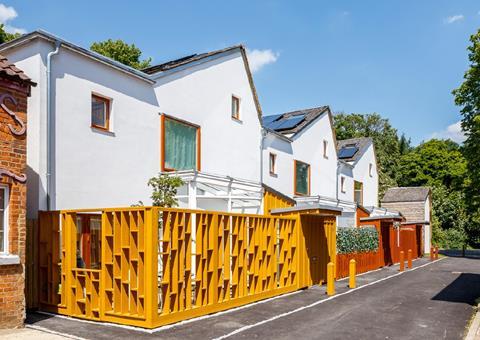Building Regs to mandate 30% cut in carbon emissions from new homes and 27% from other buildings from this summer - architects react
Updated: More industry reaction added
All new buildings must reduce their carbon emissions by about a third, the government announced today.
Building Regulations will be amended to enforce a 30% cut on emissions from new homes and a 27% cut on other buildings.
The new rules will come into force in June, with a transition period to allow for planning applications that are in progress at the time.
Junior housing minister Eddie Hughes said the change would pave the way for the Future Homes and Buildings Standard in 2025 and would mean all future homes would be net zero-ready and would not need retrofitting.
“The changes will significantly improve the energy efficiency of the buildings where we live, work and spend our free time and are an important step on our country’s journey towards a cleaner, greener built environment,” he said.

The announcements were set out in the Department for Levelling-Up, Housing and Communities (DLUHC)’s response published today to a public consultation, which ran from January to April on the Future Buildings Standard. It details interim uplifts to Parts L and F of the Building Regulations and the introduction of Part O.
The initial response from architects was luke-warm.
RIBA president Simon Allford said: “These uplifts will bring us one step closer to decarbonisation, and we welcome that.
“The new minimum standards for fabric efficiency and new Part O signal real progress, but without regulation of actual energy use, the built environment will not decarbonise at the rate required. Regulations must continue to tighten.”
He said the RIBA would work with ministers to try and ensure the 2025 Future Homes and Buildings Standards addressed the urgency of the task at hand.
PRP partner and Building Design columnist Andrew Mellor was more downbeat.
He said: “We are currently undertaking work for clients looking at the future performance requirements of homes to hit a true net zero performance. That analysis shows that the likely Future Homes Standard requirements do not go anywhere near far enough and that developers will have to go much further to hit the RIBA 2030 standard and even further to meet the LETI standards.”
“Architects and developers need one standard from government, membership bodies and the advisory groups which achieves true net zero. Disparity between standards will not help industry to achieve the net zero goal.”
He demanded embodied carbon be included in the 2025 Future Homes Standard and said the date must not be allowed to slip like others have.
He said the new overheating assessment requirement was very welcome and should help to minimise some of the thermal comfort issues in homes and reduce the predicted annual deaths from heat stress.
Alan Fogarty, sustainability partner at multi-disciplinary engineer Cundall, welcomed the adoption of the higher targets that were proposed in the consultation documents for Part L as a ”significant step towards the ambitious reductions proposed for 2025”.
He added: ”In terms of the ventilation requirements, the consultation proposed a 50% increase in air volumes, which could have had a significant energy penalty as the ventilation systems would have to work a lot harder. This has been dropped from the latest document, which is also welcomed because if projects are designed with a net zero carbon ambition, they are likely to achieve higher rates anyway. This could readily be achieved using openable windows without an energy penalty.”
Matthew Goulcher, managing director of Levitt Bernstein, said: “As the latest IPCC report has highlighted, this will be our last chance to make a meaningful difference as a sector.
“Building Regulations must step up now if we wish to avert the devastating consequences of the climate emergency.
“While we welcome the improvements to fabric efficiency, these do not go far enough. We need to set standards that are based on actual and measurable energy use targets and then ensure that these are met in practice. We have the technology and means to do this now, so why wait another four years?”
On behalf of LETI (London Energy Transformation Initiative), which won Building Design’s Leader of the Year award in October, Alex Johnstone said: “This is a time when we need both progress and clarity in terms of metrics. The 2021 uplift has not provided these.”
The group said it was disappointed by the Part L reforms. Thomas Lefevre said: “The introduction of a primary energy metric goes against the views of the industry, who have specifically has said it is unhelpful and confusing. 80% of the consultation responses told the government that a primary energy metric should not be introduced, yet the government has not listened.”
Brian Goldsmith, UK and Europe director at engineers Elementa Consulting, said: “We understand that the 2021 regulations are an interim uplift before the FHS and the FBS but we are disappointed that DLUHC has not taken on board the industry feedback of recommendations from their consultation.
“It is good to see that the interim regulations have provided an uplift in standards, as well as the introduction of Approved Document O: Overheating. This is welcomed. However the introduction of a primary energy metric is disappointing. The key to driving building performance is the implementation of a total energy use metric that can be measured in use.”
UKGBC director Simon McWhirter praised the government for taking forward the more ambitious Part L improvement options within the consultation, alongside new requirements for tackling domestic overheating.
“This is a vital step in the right direction in the decarbonisation of our buildings,” he said.
“However, there were overarching details missing which could and should have clarified what more will be done to deliver net-zero buildings by 2050.
“Although we welcome that the government’s commitment to issue a statement of intent will address both embodied carbon and the performance gap, it was disappointing not to see these necessary, clear and ambitious proposals set out here today, particular as UKGBC’s Whole Life Carbon Roadmap demonstrates that urgent action is critical on these issues.”
The UKGBC roadmap shows that embodied carbon will form over half of all built environment emissions by 2035.
The new regulations will come into effect from June 15, 2022. The DLUHC said transitional arrangements for the next six months will mean that if a building notice, initial notice or full plans for building work are submitted to a local authority before June 15, 2022 then, provided the building work commences by June 15, 2023, work on that individual building will be permitted under the previous standards.
Ministers said the government was providing £6.6bn of direct investment into improving the energy efficiency of buildings during this Parliament through schemes such as the Social Housing Decarbonisation Fund, Local Authority Delivery scheme and Home Upgrade Grant scheme which make grants to low-income households for measures including insulation, solar panels and heat pumps.
But last year’s botched Green Homes Grant scheme was branded a failure by MPs after just 5% of the £1.5bn fund was spent in the four months before the government canned it, leaving many builders and installers in the lurch.
>> From the archive: Explainer: How the proposed Future Buildings Standard will affect the way you design
In April a coalition of architects, built environment and climate groups wrote to the permanent secretary at the then MHCLG, Jeremy Pocklington, highlighting what it described as “significant shortcomings” in the proposed Future Buildings Standard.
The 21 signatories who included the RIBA, Architects Declare, the Architects Climate Action Network and the UK Green Building Council, said the government must be far more ambitious in the way it regulates the energy consumption of new buildings.
The letter outlined serious concerns about the proposed new energy and ventilation standards for non-domestic buildings and existing homes in England. Alongside ambitious new standards, the letter also called for a national retrofit strategy to discourage the demolition of salvageable buildings.
Postscript
What do you think of the news? What will it mean for your practice? Email our newsdesk at elizabeth.hopkirk@bdonline.co.uk or use the hashtag #BDFutureProf on social media - or comment below
















4 Readers' comments